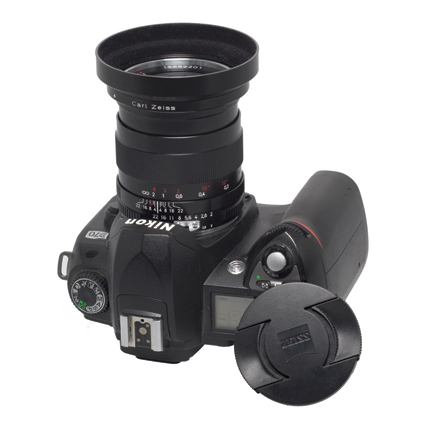The Zeiss Distagon f/2 28mm ZF Lens; A Manual Focus Lens For Film And/Or Digital SLRs
As soon as I heard about it, I wanted to try the f/2 28mm Zeiss ZF lens; ZF, for those unfamiliar with the current Zeiss line-up, is their superb line of Nikon F compatible manual focus lenses, as distinct from ZM (Leica M compatible) and ZV (classic Hasselblad compatible).
All of the ZF series are also available in ZK (Pentax K bayonet compatible) and a few, though apparently not this one, are also available in the old M42 or “Pentax screw” mount. All are the sort of lenses where, if you did not know they were in current production, you would say, “They don’t make ’em like that anymore.” But they do.
 |
|
|
As it turned out, I wanted it for completely the wrong reasons. My logic was that it would be the perfect fast “standard” lens on my Nikon D70, or indeed, for any other Nikon D-SLR with the 1.5x effective focal length multiplier (16x24mm sensor). Multiply 28mm by 1.5 and you get the equivalent of a 42mm lens on 24x36mm full-frame 35mm.
Although it’s true that I got some very nice pictures with it on the D70—well, I like them anyway—I have to say that I liked it even better on the Nikon F and Nikkormat where I tried it with real film. Why? I’ll come back to that later.
 |
|
|
First, let’s take a look at the lens. It’s big (65mm diameter, 94mm long—that’s 2.6x3.7”—and takes a 58mm filter); it’s heavy (530 g or 18.7 oz); it’s expensive (just the wrong side of $1000, street price, though if the dollar continues to weaken it may cost more by the time you read this); and it’s gorgeous. You can see where the money goes. It’s made under license by Cosina in Japan under Zeiss quality control, and the heft in the hand and the smoothness of the controls (focus, diaphragm) are second to none.
There are 10 glasses in eight groups, a classic retrofocus derivative, and despite the speed and the reverse-telephoto construction, distortion is held to about 2.1 percent at worst, about 19mm off-axis; distortion at the corners (22mm out) is actually slightly less. Vignetting at full aperture is a fraction over two stops, center to corner (which is good), and by f/4 it is well under a stop (which is excellent). All relevant figures are given on www.zeiss.com.
 |
|
|
When you are up against it in poor light, the f/2 maximum aperture makes it easy to see the subject and to focus on it, and the 28mm focal length allows longer handheld shutter speeds than a longer focal length. The old “one over focal length” rule of thumb works better with full-frame 35mm than with a 16x24mm sensor, simply because the magnification of the enlargement is less at a given print size, but I found I could get away with 1⁄30 sec on both film and the D70, and with 1⁄15 sec and even 1⁄8 sec if I slouched against a support and breathed out during the exposure (both classic tricks for avoiding camera shake).
The focusing mount has quite a long throw at about 100-110?, but this is deceptive: from infinity to 1 meter/3 feet is at most 15?, and probably only 10, while the closest focusing distance is 24cm or a bit under 10”: 1⁄5 life size on the film or sensor. At least a third of the focus travel is taken up with the last 6” or less of close focusing. As usual, there is a “feet/meter” scale, the former in red (and switching to inches at 0.4m/15”) and the latter in white. All markings are of course paint-filled engravings.
 |
|
|
The machined metal grips on the focusing ring, the diaphragm control ring, and the body of the lens itself (for mounting) all have a wonderfully “machined” feel: no rubber here. Elegantly, the diaphragm control ring is a different pattern from the mounting grip on the body of the lens, so you can tell them apart by touch with your eye to the camera. The hood is the by now familiar external three-claw bayonet; it is shared with the 2.8/25 Distagon (Zeiss always reverses the relative aperture and focal length, as compared with the conventional usage of “25/2.8”).
- Log in or register to post comments

















































